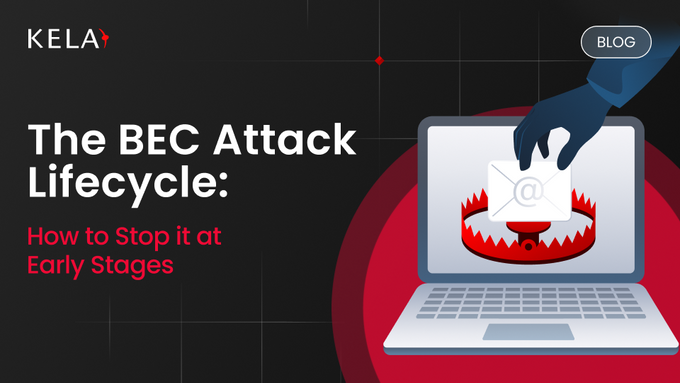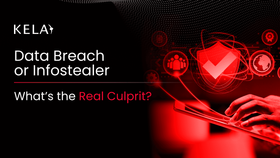The BEC Attack Lifecycle: How to Stop It at Early Stages
BEC exploits trust. Master the BEC lifecycle and apply simple, effective defenses: strong email authentication, MFA, and mandatory out-of-band verification.
Published October 23, 2025

According to a McKinsey report, phishing, Business Email Compromise (BEC), and stolen credentials are among the leading causes of cybersecurity breaches—costing organizations an average of $5 million per successful incident. The rise in ready-made BEC kits means even less experienced attackers can carry out convincing scams with minimal effort. At the same time, initial access brokers are running large-scale phishing campaigns to steal and sell login details, often to groups behind ransomware attacks. This overlap has created a steady rise in both threats across industries.
Business Email Compromise is no longer a rare occurrence but a growing challenge that relies on trust, urgency, and deception. In this blog, we will explore how BEC attacks unfold, the warning signs to watch for, and the most effective ways to build a strong defense.
» Get started for free with KELA and strengthen your cybersecurity
Understanding BEC
Business Email Compromise is a scam that targets organizations, most often resulting in an unauthorized wire transfer or the sharing of sensitive information. The attacker impersonates a trusted entity—typically an executive, a vendor, or a business partner—using email to trick an employee into performing an action that benefits the criminal.
The fraud is successful by exploiting the natural human inclination to trust authority and follow urgent instructions.
Take note: BEC differs from mass-market phishing as it relies heavily on social engineering and typically contains no malicious links or attachments, making it notoriously difficult for traditional security filters to detect.
» Learn how to prevent phishing attacks before they catch you
The Stages of a BEC Attack and Detailed Defense
A BEC attack follows a structured and multi-stage lifecycle, with each stage designed to gather intelligence, establish credibility, and ultimately, execute the fraud.
Stage 1: Reconnaissance and Target Mapping
This is the intelligence-gathering phase where attackers build a detailed profile of their target organization and key personnel. They leverage publicly available data and open-source intelligence (OSINT) tools (from social media, company websites, and public breaches) to identify key personnel, map reporting lines, and deduce internal communication patterns.
Such meticulous planning is crucial for crafting highly contextual and convincing impersonation attacks in later stages.
Best practices for prevention
Limit the sharing of trivial personal information on public platforms, as attackers can use this for password guesses or security question answers.
Exercise careful control over what information is publicly available on your company website and professional networking sites. Limit details such as direct email formats, reporting structures, and exact employee roles. This makes it harder for attackers to profile potential targe
Conduct internal reconnaissance exercises to identify and limit the organization's public exposure footprint from an attacker's perspective.
Utilize Dark Web monitoring services to detect if company credentials or confidential organizational data are being traded or discussed in underground forums.
» Here's everything you need to know about credential compromise
Stage 2: Initial Access and Impersonation
Attackers seek initial entry, either by compromising a legitimate account, EAC, or by crafting a highly deceptive external email (impersonation).
Access is mainly gained through phishing for credentials, leveraging password reuse, or by employing spoofed email addresses or look-alike domains to imitate trusted figures like executives or vendors.
Best practices for prevention
Mandate phishing-resistant Multi-Factor Authentication (MFA) for all employee accounts, especially for executives and financial staff, to prevent credential theft.
Implement and enforce strong email authentication protocols: Sender Policy Framework (SPF), DomainKeys Identified Mail (DKIM), and, most importantly, set DMARC to a policy of "reject" for unauthorized messages from your domain.
Employ advanced email security solutions that utilize AI and pattern detection to flag subtle discrepancies, such as look-alike domains or external emails impersonating internal users.
Train employees to actively check the full sender address and email header for any inconsistencies, even if the display name appears legitimate.
Did you know? MFA can prevent 99.9% of credential-based compromises, greatly reducing the risk posed by stolen passwords.
» Learn how leaked credentials differ from compromised accounts
Stage 3: Internal Observation/Attack Prep
If direct email access is obtained (Account Compromise), the attackers monitor legitimate email threads, study the user's writing style, and may set up an inbox rule to hide their activity by auto-forwarding or deleting sent items.
This preparatory stage provides the ground for formulating highly contextual and convincing fraudulent messages that blend seamlessly into ongoing business operations.
Best practices for prevention
Implement Conditional Access policies to restrict logins from anomalous geographic locations or unfamiliar devices, triggering an immediate MFA challenge or block.
Enforce logging and alerting for any changes to user mailbox settings, especially the creation of new inbox rules, auto-forwarding to external domains, or changes in folder permissions.
Conduct regular internal audits of executive and finance mailboxes for unauthorized access or unusual activity patterns, such as an excessive number of deleted items or changes to folder permissions.
Use User and Entity Behavior Analytics (UEBA) tools to establish a baseline of normal communication and flag any sudden deviations in sending patterns or topic content.
Stage 4: Payload Execution/Urgent Request
The crafted emails are sent, often leveraging social engineering tactics like authority bias and extreme urgency, intended to invoke immediate action, such as an immediate wire transfer to a fraudulent account or the sharing of sensitive information.
Attackers may beg for secrecy to avoid any sort of verification through normal channels.
Best practices for prevention
Establish mandatory, out-of-band verification protocols for all financial transactions and sensitive data requests that originate from email.
Implement dual-authorization and segregation of duties for all financial disbursements, ensuring that no single employee can approve and execute a high-value transaction.
Provide continuous, targeted security awareness training that uses real-world BEC examples. Focus on helping employees, especially those in finance, HR, and executive support, recognize psychological red flags such as urgency, secrecy, and impersonation of authority.
Institute an organizational "cool-down" period for any large, first-time wire transfer or vendor payment change to allow for a mandatory secondary review.
» Understand how threat actors breach and exploit your data
Stage 5: Post-Execution/Disbursement and Persistence
After the victim complies, the stolen funds are commonly disbursed quickly through multiple transit accounts to obscure the money trail. The attackers may choose to maintain access to the compromised account for future operations, such as targeting other employees or customers.
Next steps
Develop a clear, practiced Incident Response Plan (IRP) that outlines immediate steps for the security, finance, legal, and executive teams upon confirming a fraudulent wire transfer or data theft.
Immediately contact the financial institution and law enforcement (e.g., the FBI's Internet Crime Complaint Center, IC3) to initiate fund recovery efforts, as prompt action is critical.
The IT security team must force sign-out of all compromised sessions, revoke tokens, reset credentials using an out-of-band channel, and preserve the mailbox state for a complete forensic analysis.
Communicate quickly and clearly with all affected internal and external parties. This includes vendors or customers who may have been targeted by the compromised account, while adhering to all regulatory disclosure requirements.
» Find out why your organization needs cyber threat intelligence
The Next Frontier: Generative AI and the BEC Lifecycle
Generative AI and deepfake technologies are fundamentally changing the BEC threat, making the attack lifecycle significantly more sophisticated and convincing. Attackers now leverage Gen AI to craft hyper-realistic emails that flawlessly match an employee's known writing style, and they can produce deepfake voice or video impostors for multi-channel social engineering attacks.
This dramatically increases the difficulty for victims to discern fraud, leading to deeply embedded, long-term compromises and a surge in attack volume.
» Read more: How cybercriminals exploit the power of generative AI and what you can do about it
Early Warning Signs and Mitigation
Defenders must watch for subtle shifts in email tone, structure, or urgency in any routine communication. Increased scrutiny is vital for unexpected, urgent requests, particularly those demanding secrecy or discouraging verification.
To counter this, organizations must deploy AI-driven anomaly detection and advanced machine learning/NLP tools to flag atypical patterns and cross-reference communication topics. Crucially, robust callback verification for all financial transactions is critical, as AI can now convincingly mimic voices.
Take note: BEC is evolving into an "industrialized" threat with the rise of "BEC-as-a-Service." Attackers are weaponizing AI not just for emails but also for audio/video deepfakes, turning simple email compromise into complex, multi-channel social engineering operations targeting high-profile diverted payments.
» Now that you understand why GenAI matters, discover how a threat intelligence analyst can help you stay ahead of emerging risks
Partnering for Proactive Defense
The steady rise of BEC requires a defense strategy that strengthens both technology and people. Preventing these attacks means enforcing strict email authentication, using phishing-resistant MFA, and setting clear verification steps for financial transactions.
KELA’s Cybercrime Threat Intelligence platform supports this approach by helping you identify and respond to real threats before they escalate. Beyond detection, KELA’s Brand Protection feature adds another layer of defense—monitoring the cybercrime underground for mentions of your organization, leaked credentials, and misuse of your branding elements. This deep visibility allows you to act quickly, protect your executives and employees from targeted exploit attempts, and preserve the reputation and trust your business is built on.
» Looking for the solution? Look no further than KELA
FAQs
What is the biggest difference between BEC and standard phishing?
BEC attacks are highly targeted and primarily rely on social engineering to trick a specific employee into performing an unauthorized wire transfer or sharing sensitive data. Unlike mass-market phishing, BEC emails typically contain no malicious links or attachments, making them much harder for traditional email security filters to detect.
Why is MFA not enough to stop BEC?
MFA is critical for preventing account takeover. However, it cannot stop the core of a BEC attack: deception. The victim is socially engineered into manually sending a fraudulent wire transfer.
What is "out-of-band verification," and when should it be used?
Out-of-band verification is the mandatory process of verifying high-risk requests using a communication channel different from the one the request arrived on.
For example, if a CEO emails a request for an urgent wire transfer, the finance employee must verify it via a phone call to a known, pre-verified number for the CEO, not by replying to the email.
Which organizational departments are most commonly targeted by BEC?
The most targeted departments are Finance, HR, and Executive Administration. Targeted security awareness training must focus on these teams.





